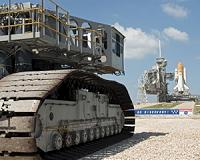 |
Cape Canaveral, Florida (AFP) Nov 2, 2010 An electrical malfunction has forced the US space agency to delay until Thursday the shuttle Discovery's final mission to the International Space Station, NASA said. "Space shuttle Discovery's launch on the STS-133 mission has been delayed until no earlier than Thursday," NASA said in a statement. The mission, initially scheduled for Monday, has been postponed three times. Earlier delays were announced so that Kennedy Space Center technicians could repair quick-disconnect fittings in the system used to pressurize one of Discovery's orbital maneuvering rocket engines.
earlier related report "Work is on schedule. We completed flight pressurization and all went well. That is behind us now," Steve Payne, NASA test director, told reporters as the countdown to launch kicked off at 2:00 pm (1800 GMT) Sunday. The mission, initially scheduled for Monday, was postponed so Kennedy Space Center technicians could repair quick-disconnect fittings in the system used to pressurize one of Discovery's orbital maneuvering rocket engines. Discovery and its six American astronauts will now launch from Florida's Kennedy Space Center at 3:52 pm (1952 GMT) Wednesday bound for the International Space Station (ISS). The weather forecast remains 70 percent for favorable conditions, Kathy Winters, Cape Canaveral's senior meteorologist, said at a press briefing, adding that there were slight concerns of possible rain and clouds in the launch area. The flight to the orbiting ISS is the fourth and final shuttle flight of the year, and the last scheduled for Discovery, the oldest in the three-shuttle fleet that is being retired in 2011. Discovery has been the busiest shuttle in history, with a record 38 trips into space since its first launch in 1984. According to NASA, it has traveled over 142 million miles (228 million kilometers) during that time, involving 5,628 orbits of the Earth over 351 days. NASA has long relied on the Discovery spacecraft at key points along its 26-year career -- the launch of the Hubble Space Telescope in 1990, the first ever female shuttle pilot Eileen Collins in 1995, and in 1998 it carried US space icon John Glenn to become the oldest human to fly in space at age 77. Its all-American crew on this voyage, including female mission specialist Nicole Stott, will deliver a pressurized logistics module called Leonardo, which will be permanently attached to the space station to give it more storage space. The shuttle will also bring Robonaut 2, the first human-like robot in space, and a permanent addition to the orbiting space station, as well as spare parts. Two space walks, for maintenance work and component installation, are scheduled. The three US shuttles -- the other two are Atlantis and Endeavour -- are due to be sent off to become museum pieces after a final shuttle mission to the space station in late February. That means Russian Soyuz spacecraft, a modernized version of which recently dropped off three fresh crew members to the ISS, doubling the crew to six, will for several years be the only vehicle for transporting humans into space. However, NASA's recently approved 2011 budget has left the door open to an additional shuttle flight in June.
Share This Article With Planet Earth
Related Links Shuttle at NASA Watch NASA TV via Space.TV Space Shuttle News at Space-Travel.Com
 Slow-Motion Giants Carry Shuttles To The Pad
Slow-Motion Giants Carry Shuttles To The PadKSC FL (SPX) Nov 02, 2010 For more than 40 years, the twin crawler-transporters at NASA's Kennedy Space Center have traveled the gravel track between the massive Vehicle Assembly Building and the two launch pads at Launch Complex 39. These mammoth beasts that first carried all the Apollo Saturn V rockets have since borne every space shuttle on the last Earth-bound leg of their journeys to space. The technolog ... read more |
|
| The content herein, unless otherwise known to be public domain, are Copyright 1995-2010 - SpaceDaily. AFP and UPI Wire Stories are copyright Agence France-Presse and United Press International. ESA Portal Reports are copyright European Space Agency. All NASA sourced material is public domain. Additional copyrights may apply in whole or part to other bona fide parties. Advertising does not imply endorsement,agreement or approval of any opinions, statements or information provided by SpaceDaily on any Web page published or hosted by SpaceDaily. Privacy Statement |